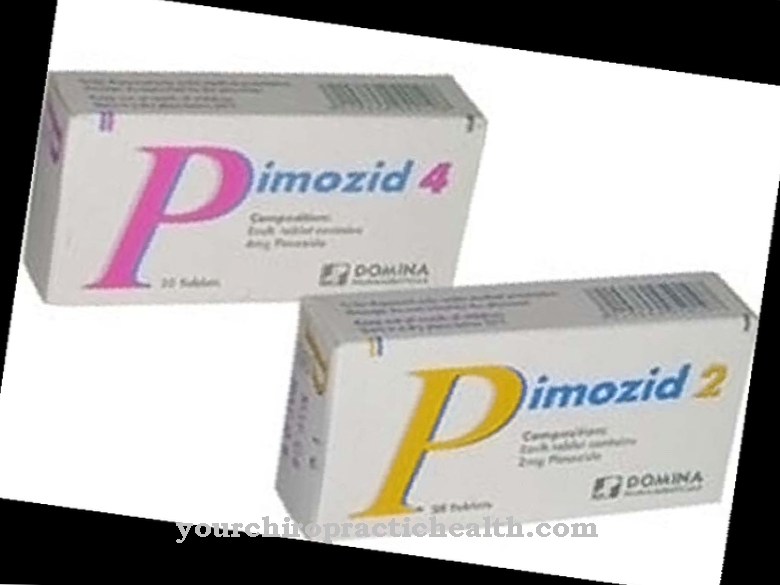Doripenem is an active ingredient that belongs to the group of carbapenems. Doripenem is therefore an antibiotic that u. a. is used to treat infectious diseases (e.g. pneumonia, infections of the urinary tract or the abdominal cavity). In the European Union, it is mainly administered by infusion.
What is Doripenem?
Doripenem is an antibiotic from the group of carbapenems. This group also includes active ingredients such as ertapenem, imipenem, doripenem, tebipenem and meropenem. They all have a wide range of antimicrobial effects. I.e. they can be used against a wide variety of bacteria.
Doripenem is sold in Germany and Austria under the trade name Doribax®. In chemistry and pharmacology, the empirical formula C 15 - H 24 - N 4 - O 6 - S 2 is used to describe the substance. The moral mass of Doripenem is 420.50 g / mol.
The drug is used to treat various infectious diseases. In medical practice, Dorpipenem is sold as a white to slightly yellowish powder. This is processed into an infusion solution before administration, as administration within the European Union takes place parenterally ("past the intestine"). The active ingredient is generally considered to be well tolerated.
Pharmacological effect
Doripenem achieves its antibacterial effect by making the cell wall synthesis of the affected bacteria impossible. The active ingredient is resistant to beta-lactase masks and extended beta-lactamases (ESBL). This is typical for antibiotics of the carbapenem group. Ertapenem, Imipenem and Doripenem work in a similar way. Due to its chemical structure, Doripenem is similar to Meropenem, another representative of the Carbapenems.
Doripenem has a wide spectrum of activity. It can be used to kill both gram-positive and gram-negative bacteria. All bacteria that stain blue under the light microscope during differential staining (Gram staining) are gram-positive. Similarly, bacteria that turn red are referred to as gram-negative. Doripenem also works against anerobes, which include numerous hospital germs that are resistant to other antibiotics.
Nevertheless, like all other representatives of the carbapenems, Doripenem is ineffective against methicillin-resistant staphylococci. Studies also report that there is good effectiveness against Pseudomonas aeruginosa and enterobacteria. This is special insofar as other representatives of the carbapenems (including ertapenem) are not effective against these bacteria, or only have a considerably reduced effect.
In the body, doripenem is broken down primarily through the kidneys (renal). The stress on this organ is correspondingly high. The extent to which the active ingredient affects an undisturbed pregnancy or embryonic or fetal development is not sufficiently well known. It must therefore not be used during pregnancy. The same applies to breastfeeding.
Medical application & use
Doripenem is given to fight all kinds of infectious diseases. The most important areas of application in adults include a complicated (i.e. not just insignificant) infection of the urinary tract, a complicated intra-abdominal infection (acute infections within the abdominal cavity) and nosocomial pneumonia (acute or chronic infections of the lung tissue).
Doripenem is particularly prescribed for infections caused by the use of a ventilator. This is due to the fact that a comparatively good effect against multi-resistant hospital germs could be proven.
Doripenem is supplied as a white to off-white powder and made into an infection solution. This is because the administration is usually parenteral and takes about an hour. In seriously ill patients who suffer from inflammation of the lungs (pneumonia), the infusion time is increased to up to four hours. The standard dose for a healthy adult of average weight is 500 mg. It has to be repeated every eight hours.
Risks & side effects
Doripenem can also lead to undesirable side effects. In studies, side effects occurred on average in a third of the test persons, which is why the active ingredient is generally considered to be well tolerated.
The side effects known to date that can be caused by doripenem include the development of oral candidiasis or mycosis of the vulva. Occasionally (less than 1 in 1,000 patients, but more than 1 in 100), thrombocytopenia and neutropenia have also occurred.
Hypersensitivity can also occur. In this case there is a contraindication. This means that it should not be used at all. Doripenem must also not be used if there is hypersensitivity to other carbapenems.
Common (less than 1 in 100, but more than 1 in 10 patients) experienced diarrhea, nausea, and headache. Also to be considered is the possibility that doripenem could develop a rash.
Doripenem is hardly processed via the cytochrome P450 enzyme system. There are therefore hardly any interactions with other drugs. However, serum levels must be monitored as carbapenems can lower serum valproic acid levels.
Since the breakdown of doripenem mainly takes place via the kidneys, increased caution is required in the event of an existing dysfunction. Treatment should then be avoided altogether or only given with a low dose.








.jpg)



















